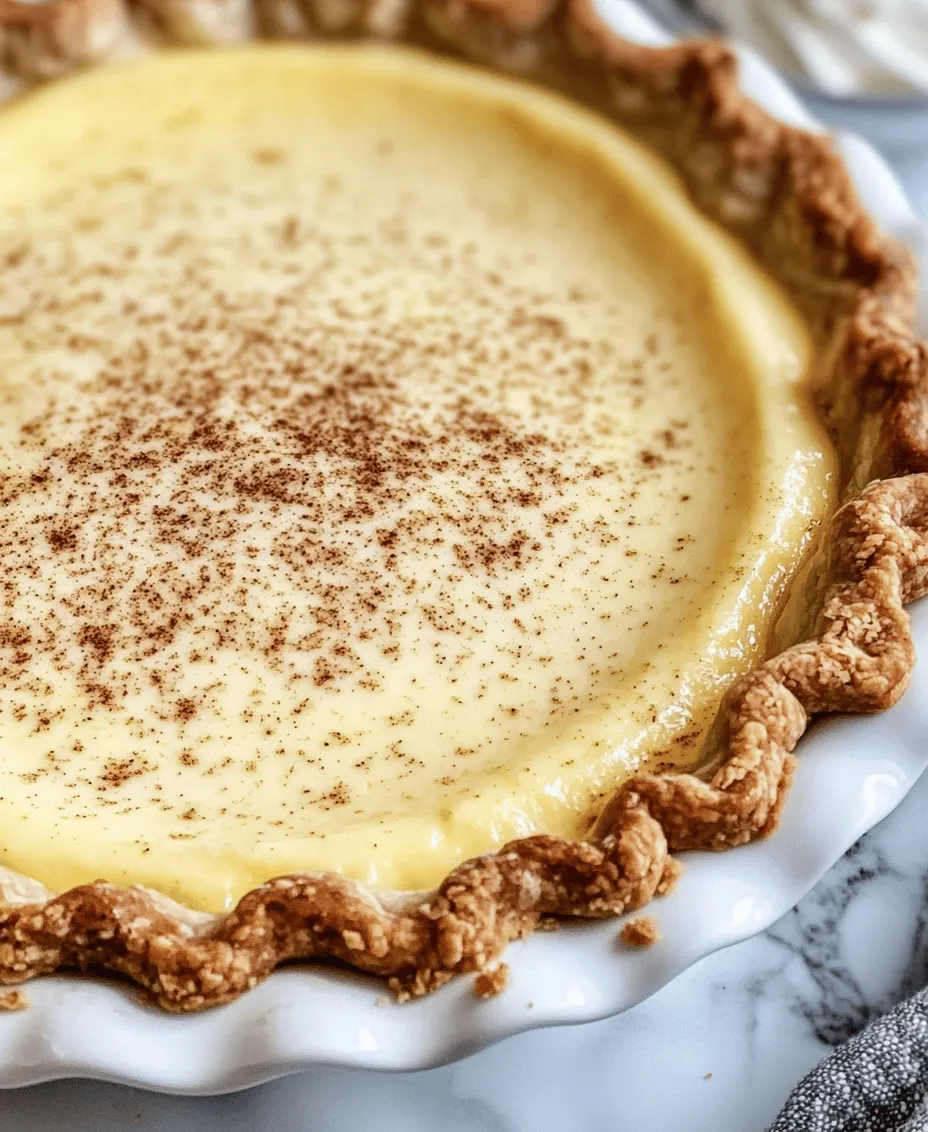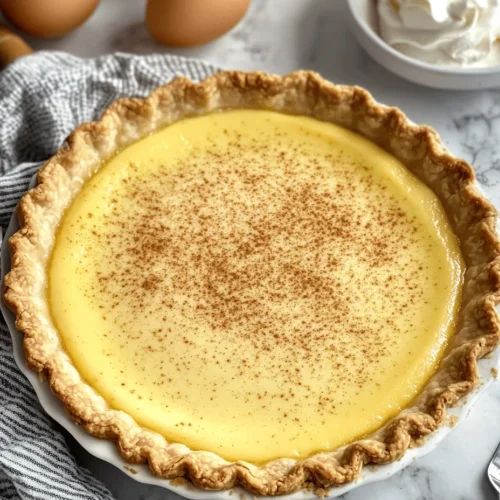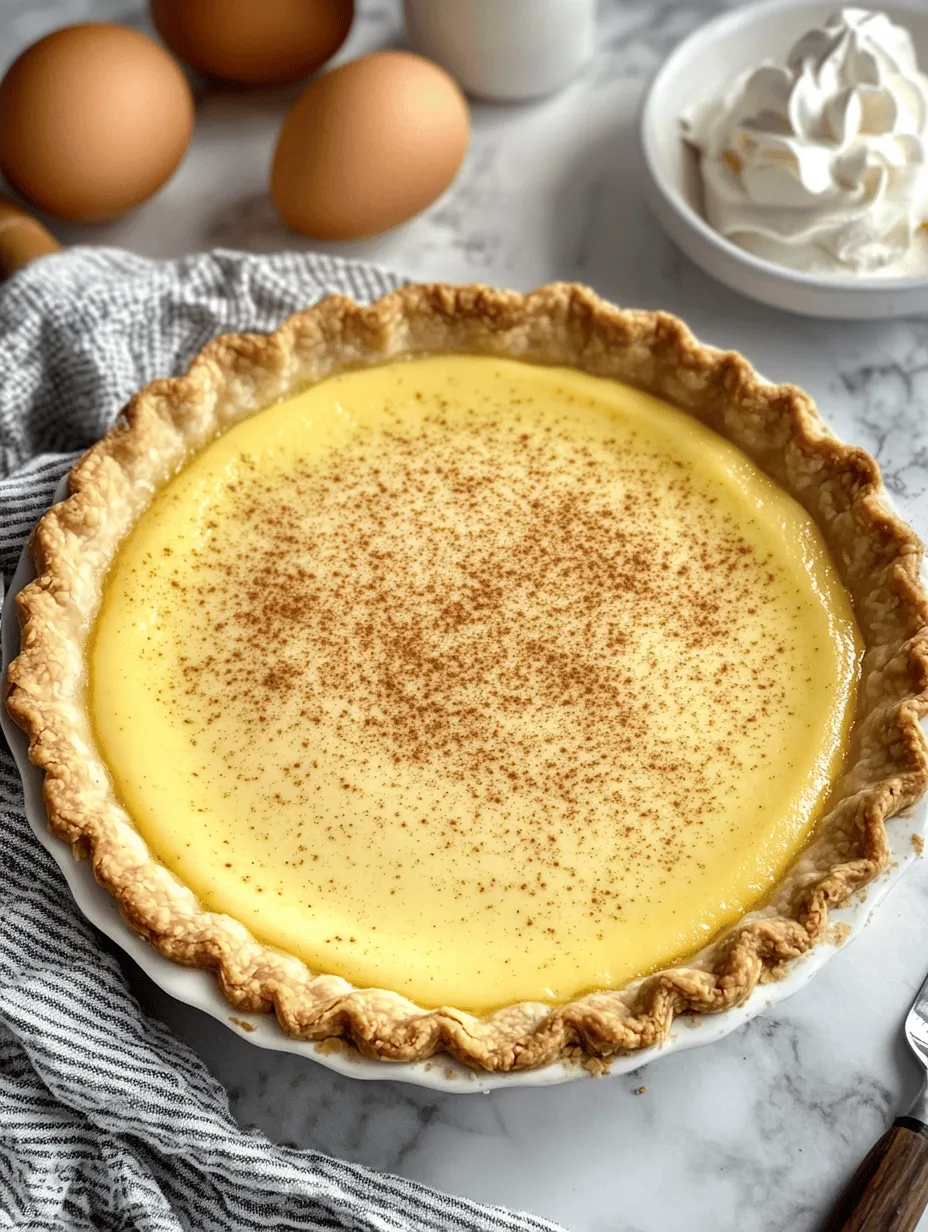When it comes to desserts that evoke feelings of nostalgia and comfort, few can rival the classic creamy egg custard pie. This dessert has graced tables for generations, representing simple pleasures and heartfelt gatherings. With its velvety smooth texture and rich flavor, egg custard pie is a testament to the beauty of homemade treats. Each slice embodies warmth and familiarity, making it the perfect dessert for family gatherings, holiday celebrations, or even a cozy evening at home.
Egg custard pie is not only easy to prepare but also features a short list of ingredients that come together to create a delightful culinary experience. The beauty of this pie lies in its simplicity, allowing the natural flavors of the eggs and cream to shine. As you embark on this journey to create your own egg custard pie, you can expect a detailed recipe that includes preparation steps, essential tips for success, and serving suggestions that will impress your family and friends.
Understanding the Components of Egg Custard Pie
To appreciate the craft of making a classic egg custard pie, it’s essential to understand the roles of its key ingredients. Each component plays a vital role in achieving that perfect custard texture and rich flavor that makes this dessert so beloved.
The Role of Eggs in Custard
At the heart of any custard is the egg, which serves as the primary thickening agent. When heated, the proteins in eggs coagulate, providing structure and body to the custard. This process is what transforms the liquid mixture into a creamy, smooth filling. It’s important to use fresh eggs for the best results, as they contribute to both the flavor and texture of the pie. The yolks, in particular, add richness and a lovely golden hue that enhances the visual appeal of the finished dessert.
The Importance of Sugar
Sugar does more than sweeten the custard; it plays a crucial role in the overall texture as well. When sugar is dissolved into the egg mixture, it lowers the freezing point of the liquid, allowing the custard to set perfectly when baked. The right balance of sugar is essential—not only does it bring out the flavors of the other ingredients, but it also helps to create that signature silky mouthfeel.
Milk: The Base of Creaminess
Whole milk is the preferred choice for making egg custard pie due to its rich, creamy consistency. The milk adds a luscious quality to the filling, making each bite indulgent and satisfying. While you may come across variations that use cream or even non-dairy alternatives, whole milk strikes the ideal balance between richness and lightness, ensuring the custard is neither too heavy nor too bland.
Flavor Enhancements: Vanilla and Nutmeg
To elevate the flavor profile of your egg custard pie, vanilla extract is a must-have ingredient. It adds a depth of flavor that complements the sweetness of the custard beautifully. The aromatic notes of vanilla enhance the overall experience, creating a fragrant and inviting dessert.
Adding a dash of nutmeg is another classic touch that brings warmth to the pie. Nutmeg’s earthy, slightly sweet flavor pairs wonderfully with the creaminess of the custard, offering a hint of spice that rounds out the pie’s flavor. When combined with vanilla, nutmeg creates a comforting aroma that will have everyone eagerly anticipating dessert.
The Utility of Salt
Salt is often overlooked in dessert recipes, but it plays an essential role in balancing sweetness. A pinch of salt in your egg custard pie helps to enhance the flavors of the other ingredients, making the custard taste richer and more complex. It’s the secret ingredient that elevates the dish from ordinary to extraordinary, ensuring that each bite is perfectly seasoned.
Preparation Steps for Classic Creamy Egg Custard Pie
Now that you understand the components that make this classic egg custard pie so special, let’s dive into the preparation steps. This process will guide you through making a delicious pie that is sure to impress.
Prepping the Pie Crust
The first step in creating your classic egg custard pie is to prepare the pie crust. While you can certainly make a homemade crust from scratch, using a pre-made pie crust can save time and yield great results.
1. Choose Your Crust: Select a pre-made pie crust from your local grocery store. A traditional pie crust works best, but you could also use a graham cracker crust for a unique twist.
2. Blind Baking: To prevent a soggy bottom, blind-baking the crust is essential. Preheat your oven to 375°F (190°C). Place the pie crust in a pie dish and prick the bottom with a fork to allow steam to escape. This step ensures that the crust retains its shape during baking.
3. Baking Process: Line the crust with parchment paper and fill it with pie weights or dried beans to keep it from puffing up. Bake in the preheated oven for about 15 minutes, or until the edges are lightly golden. Remove the weights and parchment paper, then bake for an additional 5–7 minutes until the crust is fully cooked and golden brown. Allow it to cool completely before adding the custard filling.
Whisking the Egg Mixture
The next step involves preparing the egg mixture, which is the heart of the custard pie. Follow these guidelines to achieve the perfect consistency.
1. Gather Your Ingredients: In a mixing bowl, combine the eggs, sugar, whole milk, vanilla extract, nutmeg, and a pinch of salt.
2. Whisking Technique: Start by whisking the eggs and sugar together in a large bowl. It’s crucial to whisk until the mixture is frothy and the sugar has dissolved completely. This process incorporates air into the eggs, which contributes to a lighter texture in the final custard.
3. Incorporating Milk: Gradually add the whole milk to the egg mixture while continuing to whisk. Make sure to mix until everything is well combined and smooth. Avoid over-whisking, as you don’t want to introduce too much air.
4. Strain the Mixture: For an ultra-smooth custard, consider straining the mixture through a fine-mesh sieve into another bowl or directly into the cooled pie crust. This step will catch any lumps or impurities, ensuring a silky custard texture.
Following these preparation steps will set you on the right path to creating a classic creamy egg custard pie that is sure to delight. In the next part of this article, we will explore additional tips for achieving perfect results, as well as serving suggestions that will make your dessert the star of the table. Stay tuned for more insights into this beloved recipe!

Incorporating Ingredients
When preparing your creamy egg custard pie, the technique of gradually incorporating the milk and flavorings is crucial to achieving that velvety texture. Begin by warming your milk gently before adding it to the egg mixture. This step helps to prevent the eggs from curdling, which can occur if cold milk is introduced too quickly. By slowly pouring in the milk while whisking consistently, you create a stable emulsion that ensures a smooth custard.
Additionally, this is the perfect opportunity to infuse your custard with flavorings. Classic options include vanilla extract, which adds depth and warmth, or a hint of nutmeg for a subtle spiciness. For a unique twist, consider adding a splash of almond extract or a dash of lemon zest. The key is to balance these flavors without overwhelming the custard base, so start with small amounts and adjust to taste.
Pouring and Baking
Once your custard mixture is well combined, it’s time to pour it into the prepared pie crust. This step requires care to prevent any splashes or spills. Place your pie crust on a sturdy baking sheet for easy handling. Start by slowly pouring the custard into the center of the crust, allowing it to gently flow outwards. This technique minimizes the risk of the crust breaking or the filling spilling over the edges.
For baking, preheat your oven to 350°F (175°C). The baking process is crucial for achieving the perfect custard set. Place the pie in the center of the oven and bake for approximately 40 to 50 minutes. Keep an eye on the pie towards the end of the baking time; it should be set around the edges but still slightly jiggly in the center. This slight movement indicates that the custard will continue to firm up as it cools.
To ensure even cooking and to prevent the crust from over-browning, you can use a pie shield or a strip of aluminum foil around the edges of the crust once it reaches a golden color. This helps protect it while the filling finishes baking.
Cooling the Pie
Once your pie has finished baking, it’s essential to cool it on a wire rack. This cooling method allows air to circulate around the pie, preventing moisture accumulation at the bottom, which can lead to a soggy crust. Allow the pie to cool for about 30 minutes at room temperature before placing it in the refrigerator.
Chilling the pie in the refrigerator for at least two hours is a critical step for the best texture and flavor. The cold environment helps the custard to set fully, enhancing its creamy consistency. Plus, serving the pie cold is often preferred, as it brings out the sweet, rich flavors of the custard.
Serving the Pie
When it comes to serving your classic egg custard pie, presentation can elevate the dessert to new heights. A simple yet elegant touch is to sprinkle a light dusting of freshly grated nutmeg on top just before serving. This adds a lovely aroma and visual appeal.
For those looking to add an extra indulgence, consider serving slices with a dollop of freshly whipped cream. The lightness of the whipped cream complements the richness of the custard beautifully. Alternatively, a scoop of vanilla ice cream can also provide a delightful contrast in temperature and texture.
If you want to get creative, try pairing the pie with a fruit compote or fresh berries. The acidity of the fruit cuts through the richness of the custard, creating a balanced dessert experience. A drizzle of caramel or chocolate sauce can also enhance the flavor profile, making the dessert even more decadent.
Nutritional Insights
While egg custard pie is undoubtedly a treat best enjoyed in moderation, it does offer some nutritional benefits. A standard slice of this pie (approximately 1/8 of a 9-inch pie) contains around 250-300 calories, depending on the specific ingredients and crust used. The primary ingredients—eggs, milk, and sugar—contribute essential nutrients including protein, calcium, and vitamins A and D.
Eggs are a great source of high-quality protein and healthy fats, while milk provides calcium, vital for bone health. The sugar content, while high, can be adjusted to suit personal preferences without sacrificing the overall texture and flavor of the pie.
Cultural Significance and Variations
Egg custard pie has a rich history and cultural significance in various regions. In the United States, it’s considered a classic comfort food, often associated with family gatherings and holiday meals. Its simplicity and versatility have allowed it to transcend generations, making it a beloved dessert in many households.
Regional Variations
Different cultures have put their unique spin on custard pies, leading to a delightful array of variations. For example, in England, custard tarts are a popular treat, often made with a shortcrust pastry and flavored with nutmeg or vanilla. In Portugal, the famous Pastéis de Nata features a flaky pastry shell filled with a rich egg custard that is caramelized on top, creating a crispy exterior and a creamy interior.
In Asia, egg tarts have become a staple dessert, particularly in Hong Kong and Macau. These tarts typically have a sweeter custard and are often made with a buttery, flaky crust that contrasts beautifully with the smooth filling.
Modern Interpretations
In recent years, bakers have begun to experiment with modern interpretations of the classic egg custard pie. Some may incorporate seasonal fruits, like peaches or berries, into the custard mixture for added flavor and texture. Others opt for alternative crusts, such as graham cracker or almond flour crusts, catering to gluten-free diets while maintaining that beloved custard filling.
Another trendy twist involves infusing the custard with unique flavors like matcha or chai spices, adding a contemporary flair to this traditional dessert. These variations not only reflect personal tastes but also invite creativity in the kitchen.
Conclusion: The Timeless Appeal of Egg Custard Pie
The classic creamy egg custard pie holds a special place in the hearts of many, embodying the essence of comfort and nostalgia. Its simplicity, rich texture, and delightful flavor combine to create a dessert that transcends time and generational divides. Baking this pie is more than just a culinary endeavor; it’s an opportunity to share joy and warmth with family and friends.
As you embrace the process of making this beloved dessert, remember that the heart of baking lies in the experience of creating and sharing. Whether you’re enjoying a slice at a family gathering or serving it at a festive celebration, your egg custard pie is sure to be a highlight. So gather your ingredients, follow the steps, and savor the delight of this timeless treat that has captivated palates for generations.



